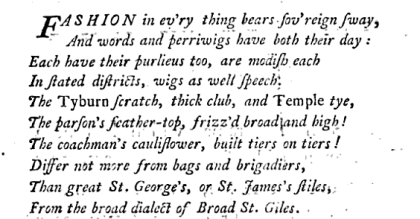Quarantine of a Pestilential Mind
Our attention now turns to another 18th century farce. This play debuted in 1775. The title is Bon Ton, High Life Above Stairs.
The author is David Garrick. George Colman wrote the prologue, and Colman also cut the play following its premiere to improve it on instructions from Garrick. The author claimed the play was written many years earlier, but there is no evidence of that beyond his statement. That statment, and the subtitle, High Life Above Stairs are asking us to link this work with the earlier High Life Below Stairs by Rev. Townley and staged by Garrick.
Bon Ton is on Google Books here.
On its surface, Bon Ton (Above Stairs) is not of a piece with Below Stairs. Yet on examination it yields identities and information that furthers our quest.
We left “Below Stairs” wondering about the Duke’s servant’s past as “apprentice to a periwig maker.” Bon Ton opens with a prologue, and we get our answer early. Here are the opening lines.
click to enlarge
Perwigs and words are interchangable the prologue tells us. Duke’s servant in Below Stairs is apprenticed to a word smith.
There are five principal characters in Bon Ton.
- Lord Minikin, whose full title is the Earl of Minikin, Viscount Periwinkle, and Baron Titmouse.
- Lady Minikin
- Sir John Trotley
- Miss Titup, her formal name is Lucretia
- and Col. Tivy.
The editors of Garrick’s Works gloss titup as a “frolicsome, capering person.” OED tells us titup is the sound made by horses’ hooves, titup, titup, titup. The OED tells us tivy is an abbreviation for tintivy, which is the sound of horses hooves, tintivy, tintivy, tintivy. The horse association for Trotley is obvious.
The editors gloss Minikin as “an affected darling.” The OED has its third meaning as “A type of plain-weave worsted baize used to make clothing in the 16th and 17th centuries.” A weave! Weaver as playwright, of course. But there’s more, specifically it’s a type of weave that was produced mainly in Essex and chiefly in Coggeshall, not 10 miles as the crow flies from Castle Hedingham, ancestral home of the Earls of Oxford. In fact, Coggeshall petitioned for a monopoly on the weave, as it was first produced there by an Italian who set up his industry in Earl John’s time. Did I mention the weave is Italian? We can say without any stretch that Lord Minikin is the writer of Italianate plays from Essex. You can learn more than you need about weaves and minikins in the Tudor period here.
In true Vere word play fashion, we are introduced to Minikin in the play when his wife, lady Minikin mentions to Miss Titup that she has seen Lord Minikin in a hackney canoodling with a woman. Titup is (unbeknownst to the Lady M.) that woman in the hackney, and we learn that Lady M is having her own affair with Col. Tivy, who is engaged to Tivy. My own take is the farce operates also as an allegory, where Titup is the Theater as art, Tivy is Theater/Business, Lady M is the nobility and Sir John Trotley is government.
The editors of Garrick’s complete works describe the characters of Bon Ton as typical of Restoration farces. The exception they note is “Sir John Trotley” who they describe as a typical Jonsonian humours character. Now the principals of the Shakespeare authorship drama were long dead and their personality traits mainly forgotten by the time Bon Ton hit the boards in 1775. But when you read the play, the model for Sir John is readily apparent. It’s Hamlet’s Polonius.
Let’s set aside Bon Ton-as-allegory for another day, as we have more important dragons to slay this St. George’s Day. We thus, progress to the end of the farce, where invariably the important facts about the allusive character identified earlier are revealed in the denouement. We recognize Vere in Lord Minikin. Now here’s the final scene.
Sir JOHN. My Lord, you’ll have something else to do.
Lord MINIKIN. • • • • • Indeed ! what is that, good Sir John?
Sir JOHN. • • •• You must meet your lawyers and creditors to-morrow, and be told, what you have always turn’d a deaf ear to, that the dissipation of your fortune and morals must be followed by years of parsimony and repentance — as you are fond of going abroad you may indulge that inclination without haying it in your power to indulge any other.
Lord MINIKIN. The bumkin is no fool, and is damn’d satirical
Sir JOHN. This kind of quarantine for pestilential minds will bring you to your senses, and make you renounce foreign vices and follies, and return with joy to your country and property again— read that, my Lord, and know your fate. {Gives a paper.}
Lord MINIKIN. What an abomination this is! that a man of fashion and a nobleman, shall be oblig’d to submit to the laws of his country.
Sir JOHN. Thank heaven, my Lord, we are in that country ! ….
The denouement of Bon Ton has the Vere character forced to face the “dissipation” of his “fortune and morals” with “years or parsimony and repentance.” he’s been accused of having “foreign vices and follies.” He’s allowed one freedom, his inclination for “going abroad” – the theater perhaps? he’s been accused of The sentence pronounced on Lord Minikin by Sir John is a “kind of quarantine for pestilential minds.” What an extraordinary phrase. And it might be the most apt and succinct description of what history did to Ned Vere ever written by anyone. And it was written by David Garrick, Mr. Shakespeare himself.



0 comments
Kick things off by filling out the form below.
Leave a Comment